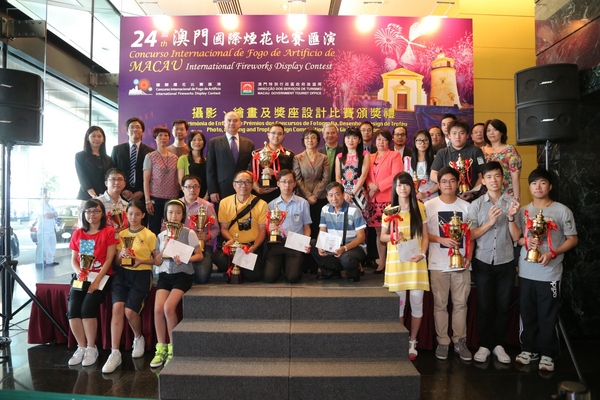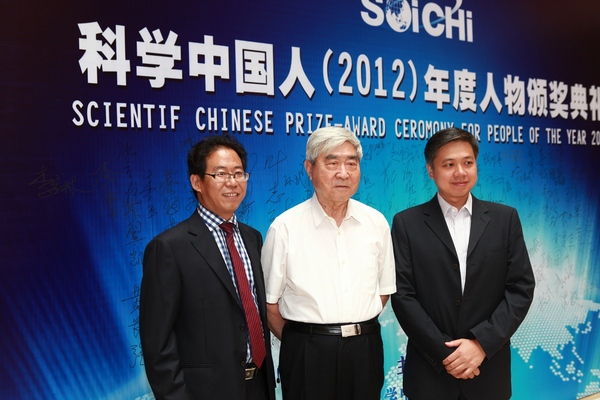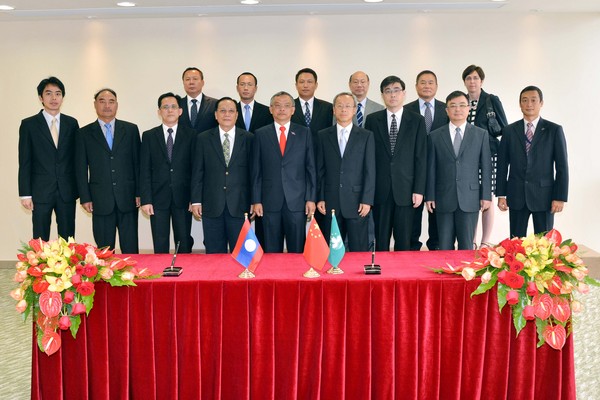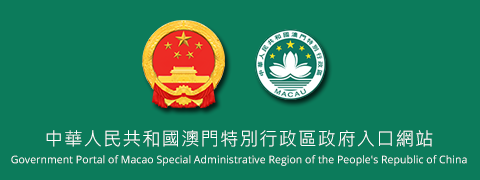Macao SAR Government Portal
News
25th Macau International Fireworks Display Contest promises a dazzling September MGTO unveils innovative elements for a spectacular program

The 25th Macau International Fireworks Display Contest is confirmed to take place at the sea area in front of Macau Tower on September 14, 19, 21, 28 and October 1. Five innovative elements will be incorporated into the fireworks display contest for a more colorful program, including the "Pyrotechnics Industry Forum" for a discussion about pyrotechnic industry development and its benefits upon tourism industry. Macau International Fireworks Display Contest is organized by Macau Government Tourist Office (MGTO). During the press conference, MGTO Director Maria Helena de Senna Fernandes unveiled the details of the contest this year. Senna Fernandes indicated that Macau International Fireworks Display Contest celebrates its 25th edition this year. In the past 24 years, the contest has won ardent support from various prominent fireworks companies around the world. The event thus enjoys wide recognition and applause among visitors and citizens, having become one of Macau's annual international events not to miss. The 25th Macau International Fireworks Display Contest will commence in mid September. Five new elements will come on stage this year including "Pyrotechnics Industry Forum", contesting teams from five continents, fireworks company participation from Africa, laser light effects and mini-movie promotion. "Pyrotechnics Industry Forum" MGTO will host the first "Pyrotechnics Industry Forum" during the contest. Fireworks industry partners from Mainland and overseas will come together for an exchange and discussion session about the applied technology, safety and development of pyrotechnic industry as well as its benefits towards tourism industry. The forum will take place from September 28 to October 1. Contesting teams from five continents The ten teams who join the contest this year cover five continents ranging from Asia, Europe, America, Oceania to Africa. They include fireworks companies from Spain, South Africa, Switzerland, Korea, Portugal, Australia, Italy, Canada, France and Mainland China. Among the contesting teams, four of them won the first prize in the past Macau International Fireworks Display Contest. Fireworks teams from France and China will stage their fireworks display on October 1 as a highlight on the National Day. New Contestant from Africa
This year marks the first year of having an African fireworks company to join the contest, while the Canadian, Swiss and Mainland China fireworks companies are staging their first show in Macau. The new contestants include Fireworks for Africa from South Africa, SUGYP SA – Swiss Professional Fireworks from Switzerland, GFA PYRO (Groupe Fiatlux-Ampleman) from Canada and Liuyang Dancing Fireworks Group from Mainland China. Fireworks for Africa won numerous awards in international fireworks competitions and presented the fireworks show in the opening and closing ceremonies of the 2010 FIFA World Cup. On the other hand, SUGYP SA – Swiss Professional Fireworks from Switzerland took part in a variety of international contests and music fireworks shows, whereas the Canadian company GFA PYRO boasts its pyrotechnic experience for over a century and its regular participation in domestic and overseas fireworks contests and festivities. Based in Liuyang, Hunan, renowned as the "Home of Fireworks" in China, Liuyang Dancing Fireworks Group was the organizer of the fireworks evening for the 60th Anniversary of the National Day at Tiananmen, Beijing in 2009 and the opening ceremony of World Expo 2010 Shanghai China. The company also presented the fireworks display in Asian Games 2010. Four of the participating teams come back this year as the first winners in title of Macau International Fireworks Display Contest and demonstrate competitive strength. Among them, BREZAC Artifices from France joined the Macau fireworks display contest four times and won high rankings including two first awards, while Panzera-Industria from Italy won two championship in Macau; on the other hand, the fireworks companies from Spain and Portugal both ranked as the first prize winner before in Macau, whereas Infinity Pyrotechnic from Australia won the third place last year. The experienced teams rival each other in strength this year and will bring forth a myriad of resplendent fireworks, bringing beautiful memories for visitors and citizens. Laser light effects MGTO requested the teams to complement their fireworks with not only music as usual but also laser light effects for the first time to enhance the audience's enjoyment with a more fascinating light and sound spectacular. For reason of nautical safety, each interval between every two fireworks displays will be reduced this year. The first display will start on 9 p.m. as usual, followed by the second display on 9:40 p.m. Every display will span 18 minutes. Spectators can listen to the live broadcast of the fireworks' background music on TDM - Radio Macau's Chinese Channel every fireworks night. MGTO and Companhia de Telecomunicações de Macau S.A.R.L. (CTM) have co-launched "Macau International Fireworks Display Contest SMS Game" since 2010. The game has won enthusiastic feedback with over 3,000 text messages last year. MGTO will again present the SMS Game with CTM this year to foster citizens' participation in the event. Mini-Movie Promotion MGTO joins hands with a television broadcast company in Hong Kong to produce a mini movie as an unprecedented promotional feature this year. The mini movie will be broadcasted on numerous TV and online channels owned by the company for a widespread promotion effect. The office is also actively promoting this year's fireworks display contest through various international, regional and local media and promotion channels, including advertisements broadcasted through international media in neighboring regions and published through key media in Mainland, Hong Kong and Macau, e.g. electronic media and travel magazines. Others include poster and leaflet distribution, etc. The event is also widely promoted in regional and overseas travel fairs or exhibitions. Moreover, the office uses the Internet as a promotion platform by launching a theme webpage about Macau International Fireworks Display Contest on MGTO's website. MGTO and the General Union of Neighbors Association of Macau will jointly present the Fireworks Carnival again to add fun and colors to the fireworks evenings. Over 30,000 individuals enjoyed the five-day Fireworks Carnival last year. The Trophy Design Contest, Photo Contest and Student Drawing Contest for the 25th Macau International Fireworks Display Contest accept applications starting from today. An award ceremony was held today (June 27) for the winners of the Trophy Design Contest, Photo Contest and Student Drawing Contest for the last Macau International Fireworks Display Contest.
…
Consumer Council released June’s ‘Supermarket Price Survey’
Consumer Council released its 'Supermarket Price Survey' of June. When comparing the data found in May, 42 percent of the surveyed products recorded a decrease in the average prices, 32 percent of the products had recorded a slight increase and 26 percent of the products remained no change in price.
Consumer Council collected prices of over 300 products in its latest 'Supermarket Price Survey' dated 20th June. In comparison with the 336 products surveyed in May, prices of 140 products had been decreased by 1 to 2 percent, and these items included canned foods, seasonings and sanitary & hygienic products. For the 109 products which recorded price increases, the item was mainly beverages. Most of the beverage brands surveyed had recorded an increase in price of over 10 percent. 87 products surveyed had remained no change in price, and the overall prices of various rice brands remained stable. The Council also analyzed the numbers of lowest price products available in the 15 supermarkets surveyed. Tai Fung supermarket in Taipa recorded the most numbers of lowest price items in which 108 items sold at Taipa Tai Fung recorded the lowest price among all surveyed supermarkets. Tai Fung supermarket at Fai Chi Kei Vai Choi branch ranked the second, with 79 of its on-shelf items having the lowest price, and the third place went to Park'n Shop located at R. Areia Preta, with 68 of its on-shelf items being recorded with the lowest price. Starting this month, consumers can make price comparison in a more convenient way by accessing to the function of 'Lowest Price in Town' of the 'Supermarket Price Information Platform' iPhone and Android apps where they can browse the latest numbers of lowest price products found in the 15 surveyed supermarkets. Among the 4 supermarket chains surveyed, selling prices were found to vary in different branches in different regions and price discrepancies were observed especially in branches of San Miu and Tai Fung supermarkets. Over 70 percent of the 230 on-shelf items found in both San Miu supermarket R. dos Mercadores branch and Nape branch were found to have price differences, of which the items of cooking oil and canned foods were found to have price discrepancies from 5 to over 10 percent. For Tai Fung supermarkets, price differences by up to 30 percent were observed in the 220 on-shelf items sold at its Taipa branch and Fai Chi Kei Vai Choi branch. The items that were found to have price discrepancies were mainly seasonings, snacks and household cleansing products. Prices of over 10 products sold in the two Royal supermarket branches and 30 products sold in the two Park'n Shop branches surveyed were also found to have price differences. Although the numbers of products found in above mentioned supermarket branches were fewer than those found in San Miu supermarket and Tai Fung supermarket branches, yet the price discrepancies of the same brand of products were greater, with a percentage difference of up to 42 percent. Consumers are advised to check with the information available on the Council's website (www.consumer.gov.mo), especially the function of 'Top Ten Price Differences'. Consumers can also download the 'Supermarket Price Information Platform' iPhone and Android apps to make price comparisons.
The latest 'Supermarket Price Survey' is now available on Consumer Council's website (www.consumer.gov.mo), and the 'Supermarket Price Information Platform' iPhone and Android apps. The survey is also available free of charge at the offices of Consumer Council, IACM's Iao Hon and S. Domingos Markets, bookstores and libraries. Consumers may also access the resources through WAP channels on their mobile phones. For enquiry, please call 8988 9315.
…
Sino-Portuguese Fund formally launched
The Cooperation and Development Fund between China and Portuguese-speaking Countries, which is proposed by the Chinese government and jointly undertaken by the China Development Bank and the Industrial and Commercial Bank of China (Macao), was formally inaugurated on 26 June 2013. The Sino-Portuguese fund amounts to one billion US dollars, with initial capital jointly provided by founding investors China Development Bank Capital Corp and the Industrial and Commercial Development Fund of Macao. The fund's initial capital stands at 125 million US dollars, with 50 million US dollars coming from the Industrial and Commercial Development Fund of Macao. The fund will focus on the investment and financing needs of enterprises in mainland China and Portuguese-speaking countries, including those in Macao. In particular, it will support mainland China and Macao enterprises to branch out into Portuguese-speaking countries, and help enterprises in Lusophone countries to break into the Chinese market. The fund's target industries include infrastructure, transport, telecommunication, energy, agriculture and natural resources, with the major goal of boosting economic cooperation and bilateral investments between China and Portuguese-speaking countries. Thanks to Macao's role as a platform between China and Portuguese-speaking countries, bilateral trade between the two parties has increased steadily. In 2012, the total value of bilateral import and export between the two sides hit 128.5 billion US dollars, a year-on-year rise of 9.6 percent. In the same year, bilateral trade between Macao and Portuguese-speaking countries was valued at 523 million patacas. The establishment of the Sino-Portuguese fund is believed to further enhance the scope of economic cooperation between China and Lusophone countries. The fund is run and managed by the China-Africa Development Fund under the China Development Bank.
…
Specific price survey results on instant drinks
Consumer Council conducted its specific price survey on instant drinks on 26th June for the implementation of Section 2b), Article 10, Law 4/95/M of 12th June. Result of the mentioned survey has been uploaded to the Council's website (www.consumer.gov.mo) and is available in the Council's 'Supermarket Price Information Platform' iPhone and Android apps. For inquiry, please call the Council's hotline: 8988 9315.
…
Prof. Ben U named Scientific Chinese of the Year 2012(UPDATE)

University of Macau (UM) professor Ben U Seng Pan was named Scientific Chinese of the Year 2012 (Information Technology and Electronics category), in recognition of his outstanding contributions in the field of microelectronics. Prof. U is the first from Macao to receive this prestigious honour. A total of 136 people received the honour this year, including well-known academicians such as Wang Xiaomo, Lu Shibi, Zhu Yingfu, and Xue Qikun; Zhang Bonan, chief designer of Shenzhou Spaceship and Tiangong-1; Weng Zhenping, director of the 702nd Research Institute, CSIC; and Wang Jun, director of BGI. "Scientific Chinese of the Year" is a prestigious title conferred upon scientists who are dedicated to scientific research, dare to innovate, have achieved major breakthroughs in their research, and with significant impact on the advancement of science and technology as well as outstanding contributions to technology transfer in China. The selection criteria include influence, creativity, potential for technology transfer, and sense of responsibility. Prof. U is the first from Macao to ever receive this prestigious honour. Prof. U is a professor in the Department of Electrical and Computer Engineering at UM, and deputy director of the State Key Laboratory of Analog and Mixed-Signal VLSI. Over the past two decades, Prof. U has been fruitful in both teaching and research. He has supervised many outstanding graduates in microelectronics, and has received numerous honours for his research achievements. UM's microelectronics team, led by Prof. U and Prof. Rui Martins, vice rector (research) of UM, and mainly consisting of UM faculty members and students, are dedicated to the design and development of technologies for high performance analog and mixed-signal circuits. They overcame numerous technical challenges and developed a dozen internationally advanced technologies, filling the gap in the research, technology transfer and industrialisation of state-of-the-art microelectronic technologies in Macao. The team's research results have been presented at the International Solid-State Circuits Conference of the Institute of Electrical and Electronics Engineers, which is considered "the Chip Olympics", and have led to over 150 papers, several US patents, and over ten other awards and prizes. Prof. U has always spared no effort in promoting the industrialisation of research results. In 2001 he co-founded Chipidea Microelectronics (Macau) (now known as Synopsys Macau), the sole innovative-technology integrated circuits design company in Macao. Prof. U and his team are dedicated to the research and development of analog mixed-signal IP for well-known consumer electronic products. He received Macao's first Prize for Scientific and Technological Innovation from the Ho Leung Ho Lee Foundation, the second-class State Scientific and Technological Progress Award, and the 2012 World Chapter of the Year Award for the Macao Chapter of the IEEE Solid-State Circuits Society. The awards ceremony for recipients of the title "Scientific Chinese of the Year 2012" was held in Beijing on 22 June. This year a total of 400 people were nominated. 136 were awarded across 16 categories, including 13 well-known academicians (such as Wang Xiaomo, Lu Shibi, Zhu Yingfu, and Xue Qikun); Zhang Bonan, chief designer of Shenzhou Spaceship and Tiangong-1; Weng Zhenping, director of the 702nd Research Institute, CSIC; Wang Jun, director of BGI; Liu Yunjie, who is a member of the Chinese Academy of Engineering, considered the father of the Internet in China, and was named by Times magazine among the top 50 most influential IT people in the world. The "Scientific Chinese of the Year" activity was launched in 2002. So far more than 200 eminent individuals have received this prestigious honour, including Yuan Longping, Yang Zhenning, Bai Chunli, Sun Jiadong, Min Enze, Shi Changxu, Xu Guangxian, Gu Binglin, Deng Zhonghan, Huang Boyun, and Chen Chuangtian.
…
Results of Employment Survey for March – May 2013
Information from the Statistics and Census Service (DSEC) indicated that the employment situation in Macao continued to be encouraging. The unemployment rate for March - May 2013 was 1.8%, down by 0.1 percentage point over the previous period (February-April); the underemployment rate held stable at 0.8%. Total labour force was 360,700 and the labour force participation rate stood at 72.0%. Total employment reached 354,400, up by 2,000 over the previous period. Analysed by industry, increase in employment was observed in Restaurants & Similar Activities and Wholesale Trade. Number of the unemployed totalled 6,400, a decrease of 600 from the previous period; fresh labour force entrants searching for their first job accounted for 3.0% of the total unemployed, down by 1.2 percentage points. In comparison with March-May 2012, the labour force participation rate rose by 0.1 percentage point; the unemployment rate dropped by 0.2 percentage points, while the underemployment rate stayed unchanged.
…
CE congratulates successful return of Shenzhou-10
The Chief Executive, Mr Chui Sai On, today (Wednesday 26 June) sent a congratulatory message to the Central Government on the successful return of the Shenzhou-10 manned spacecraft. On behalf of the Government of the Macao SAR, the Chief Executive expressed in the message the warmest congratulations on the successful completion of the Shenzhou-10 mission. The Chief Executive also conveyed his highest respect and sincere greetings to the three astronauts and all those who had contributed to the development of the country's aerospace industry. Mr Chui said the majority of Macao people had followed with great interest the flight of the spacecraft during the last two weeks, and were filled with joy and enthusiasm for the country's achievements in aerospace industry. He noted that a group of Macao students who had watched and listened the amazing lecture delivered from space, had been given impetus to explore knowledge and pursue aspiration of excellence. "The successful completion of the Shenzhou-10 manned spacecraft mission symbolises the manned space programme has entered a brand new phase in manned space engineering, bringing about new dreams and challenges in space exploration for the Chinese nation," Mr Chui pointed out. He added that the Macao SAR Government, together with Macao compatriots, would continue to support and contribute to the development of manned spacecraft programme of the motherland. The re-entry module of Shenzhou-10 landed safely on a sun-lit prairie in north China's Inner Mongolia Autonomous Region about 8:07 a.m today.
…
Specific price survey results on instant noodles
Consumer Council conducted its specific price survey on instant noodles on 25th June for the implementation of Section 2b), Article 10, Law 4/95/M of 12th June. Result of the mentioned survey has been uploaded to the Council's website (www.consumer.gov.mo) and is available in the Council's 'Supermarket Price Information Platform' iPhone and Android apps. For inquiry, please call the Council's hotline: 8988 9315.
…
Macao Orchestra and Spanish pianist Iván Martín perform Chopin’s Piano Concerto No. 1
The Macao Orchestra (OM), under the auspices of the Cultural Affairs Bureau, presents the concert Cantabile, on June 29th, Saturday, at 8pm, at the Macao Cultural Centre Grand Auditorium, starring Spanish pianist Iván Martín. Directed by Lü Jia, its Artistic Director and Principal Conductor, the programme includes Chopin's Piano Concerto No. 1 in E minor, Op 11, the overture to Mozart's opera The Magic Flute and Dvořák's Symphony no. 7 in D minor, Op 70. Iván Martín is one of the most outstanding artists of his generation in today's Spanish musical panorama. He has won several competitions such as the Infanta Cristina Piano Competition, the Marisa Montiel International Piano Competition, the Juventudes Musicales Award, the Frechilla-Zuloaga Piano Competition, the Antoni Torrandell Piano Competition, the Pedro Espinosa Piano Competition, the Mozart International Piano Competition and the Arenas School Competition. He began his musical studies at the age of five and has already appeared in major concert halls in Spain, Portugal, France, Italy, Germany, the Czech Republic, Slovakia, Albania, South Africa, South America, Mexico, the USA, among others, receiving positive reviews not only from music circles but also the public. Martin is recognised by his "sublime and elegant style and exquisite sensitivity". In this concert, the pianist joins OM to perform Chopin's Piano Concerto No. 1 in E minor. Chopin only wrote two piano concertos in his short life, featuring exquisite and soft melodies, rich in colour and emotion, yet technically demanding. Tickets for the concert Cantabile may be purchased through the Macao Ticketing Network, or the reservation hotline 2855 5555, at MOP 150, 120 and 80. For more information, please visit the Macao Orchestra website at www.icm.gov.mo/om.
…
Macao and Lao officially signed bilateral air services agreement which establishes open skies for the air transport market between the two places

The Air Services Agreement between the Macao Special Administrative Region (SAR) and the Lao People's Democratic Republic was officially signed today in Macao. Both parties have granted each other the fifth freedom traffic rights with no restrictions, hence creating liberal conditions for the operation of air services by the airlines of both places who will be interested to fly in the future. The signing ceremony was convened in the meeting room of the Cabinet of the Secretary for Transport and Public Works at 12:00 noon. The signatories were the Secretary for Transport and Public Works of the Macao SAR, Mr. Lau Si Io, and the Minister of Public Works and Transport of Lao People's Democratic Republic, Mr. Sommad Pholsena. Guests who were present in the ceremony were the Deputy Commissioner of the Ministry of Foreign Affairs of the Central People's Government in Macao SAR, Mr. Feng Tie, the Chief of the Cabinet of the Secretary for Transport and Public Works of the Macao SAR, Mr. Wong Chan Tong, the President of the Civil Aviation Authority of Macao SAR, Mr. Chan Weng Hong, the representatives from the Macau International Airport Co. Ltd. and Air Macau Co. Ltd., as well as the government officials and the airline representatives from Lao. In accordance with the Agreement, the two governments can designate more than one airline to operate the routes; the designated airlines can enjoy fifth freedom traffic rights with no restrictions to develop their passenger or cargo services between the two places. The two governments also held a courtesy meeting before the signing ceremony to exchange the updates about the economic development of Macao and Lao, especially the air transport markets. Both sides agreed that the Air Services Agreement has paved favourable conditions for the operation of air services between Macao and Lao in the future.
…

